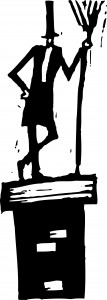What Are the Parts of the Chimney and Their Purpose?
Having a chimney and fireplace in the home is a great way to warm up a cold winter night. However, many homeowners feel that they would be better off without one when the chimney starts to malfunction. In many cases, though, the problem is a fairly simple one to fix. The key to determining the cause and severity of chimney issues is understanding all of the parts of the chimney and what they do. This will also help you communicate with the sweep who inspects your chimney each year.

At your annual chimney cleaning & inspection, you will have a better understanding if you are familiar with the parts of your chimney.
Beginning with the uppermost part of the chimney, there is a spark arrestor. The purpose of the spark arrestor is to prevent sparks from getting out of the chimney. When the wind is blowing in a particular way, a spark that seems harmless can quickly turn into a blazing roof fire. This will not only damage the home where the fire started but roof fires can actually jump to neighboring homes and spread throughout the neighborhood. For this reason, the spark arrestor is one of the most important pieces of the chimney.
Moving downward from the spark arrestor is the chimney crown, a simple cement structure. The purpose of the chimney crown is to offer extra protection for the bricks on the outermost layer of the chimney. In particular, it keeps foreign objects and excessive amounts of water from getting into the chimney. If a chimney suffers water damage, it could compromise the structural integrity of the entire system and pose some serious safety hazards.
The lengthy piece that most people refer to as a chimney is actually called the flue. All homes should have a flue liner installed to protect the inside of this structure. Flue liners are available in a wide array of materials, but many homeowners find that stainless steel is the most durable while also offering maximum protection. In homes that were built prior to the 1950s, there may not be a flue liner so it is important to check for one before using the fireplace and chimney.
The damper is a piece inside of the chimney that is used to open and close the flue. It is very important to make sure that the damper is always open when making a fire in the fireplace. In many cases, people think that a smoking chimney is a sign of a major problem when it is actually just that the damper is closed. This is a common mistake, so be sure to check carefully before each use of the fireplace.
The inside of the chimney also features a piece called the smoke shelf. The smoke shelf is in place to catch material that may fall from inside of the chimney. There are many things that get into the chimney when they should not, such as leaves or animal nests. If they fall all the way through and into the fire, it may blaze out of control and become dangerous.
The smoke chamber is one of the most important parts of the chimney because it compresses combustible gasses. If the smoke chamber is not functioning properly, these gasses may enter the home instead of leaving through the flue. In this situation, the entire home is at risk for carbon monoxide poisoning and other serious illnesses.
A chimney may look like a simple structure but it actually has many parts that must function perfectly in order for it to be safe. Understanding each of these parts and their functions is the best way to properly maintain a chimney. Having this knowledge also helps homeowners to identify potential problems quickly and accurately.
